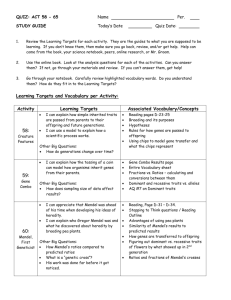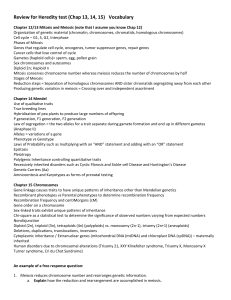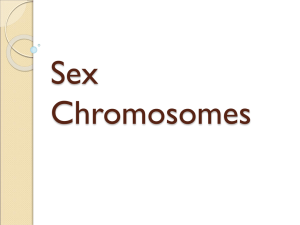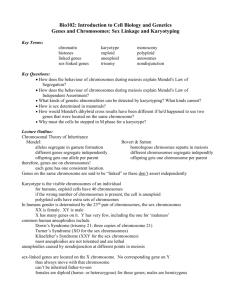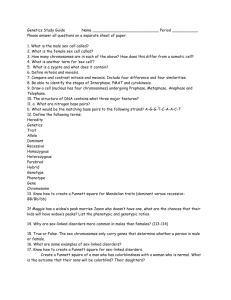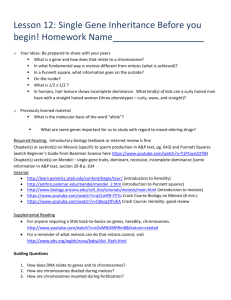Genetics Notes Overview
advertisement
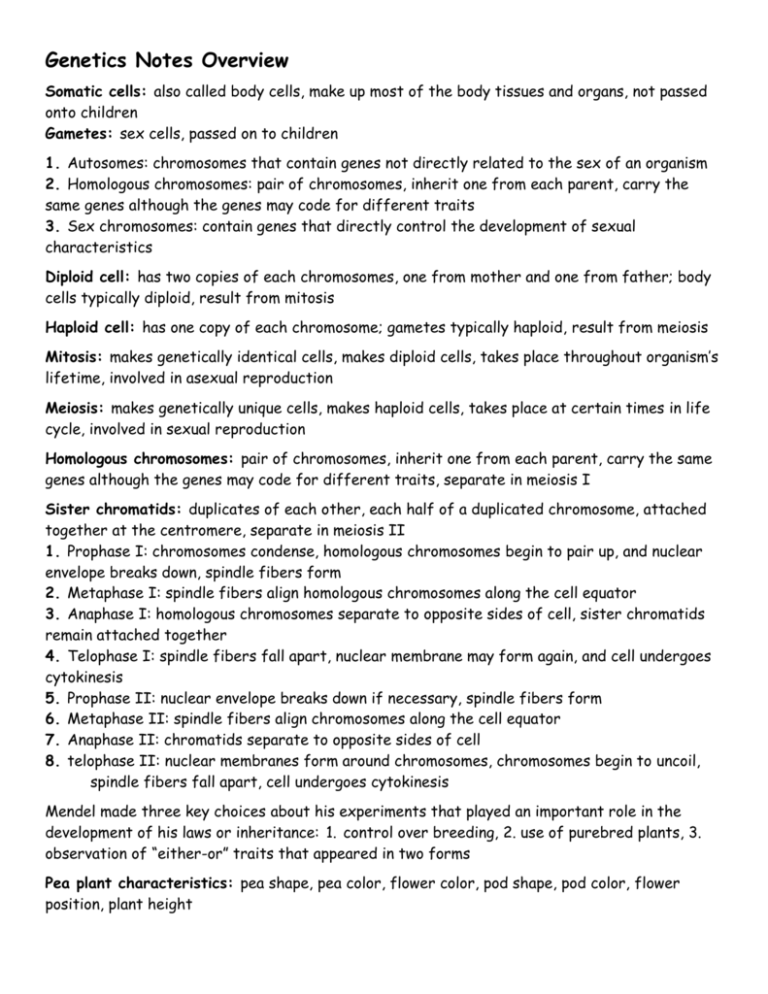
Genetics Notes Overview Somatic cells: also called body cells, make up most of the body tissues and organs, not passed onto children Gametes: sex cells, passed on to children 1. Autosomes: chromosomes that contain genes not directly related to the sex of an organism 2. Homologous chromosomes: pair of chromosomes, inherit one from each parent, carry the same genes although the genes may code for different traits 3. Sex chromosomes: contain genes that directly control the development of sexual characteristics Diploid cell: has two copies of each chromosomes, one from mother and one from father; body cells typically diploid, result from mitosis Haploid cell: has one copy of each chromosome; gametes typically haploid, result from meiosis Mitosis: makes genetically identical cells, makes diploid cells, takes place throughout organism’s lifetime, involved in asexual reproduction Meiosis: makes genetically unique cells, makes haploid cells, takes place at certain times in life cycle, involved in sexual reproduction Homologous chromosomes: pair of chromosomes, inherit one from each parent, carry the same genes although the genes may code for different traits, separate in meiosis I Sister chromatids: duplicates of each other, each half of a duplicated chromosome, attached together at the centromere, separate in meiosis II 1. Prophase I: chromosomes condense, homologous chromosomes begin to pair up, and nuclear envelope breaks down, spindle fibers form 2. Metaphase I: spindle fibers align homologous chromosomes along the cell equator 3. Anaphase I: homologous chromosomes separate to opposite sides of cell, sister chromatids remain attached together 4. Telophase I: spindle fibers fall apart, nuclear membrane may form again, and cell undergoes cytokinesis 5. Prophase II: nuclear envelope breaks down if necessary, spindle fibers form 6. Metaphase II: spindle fibers align chromosomes along the cell equator 7. Anaphase II: chromatids separate to opposite sides of cell 8. telophase II: nuclear membranes form around chromosomes, chromosomes begin to uncoil, spindle fibers fall apart, cell undergoes cytokinesis Mendel made three key choices about his experiments that played an important role in the development of his laws or inheritance: 1. control over breeding, 2. use of purebred plants, 3. observation of “either-or” traits that appeared in two forms Pea plant characteristics: pea shape, pea color, flower color, pod shape, pod color, flower position, plant height Cross: the mating of two organisms; Mendel mated purebred pea plants with purple flowers with purebred flowers P: the parental generation; Mendel used purebred plants for the P generation; for example, he crossed purebred plants with purple flowers with purebred plants with white flowers F1: the first generation of offspring resulting from the parental cross; for example, Mendel’s F1 plants all had purple flowers; Mendel allowed this generation to self-pollinate F2: the second generation; the result of the self-pollination of F1 plants; for example, in Mendel’s F2 generation, 3/4 had purple flowers and 1/4 had white flowers Results: For all seven traits, Mendel found that approximately 3/4 of F2 offspring had one trait and 1/4 of the offspring had the other trait Conclusions: traits are inherited as discrete units (genes), law of segregation—inherit two copies of each gene, donate only one copy of each gene in gametes Gene: piece of DNA that tells a cell to make a certain polypeptide Allele: an alternate form of a gene; there may be many different forms of the same gene in a population; each individual organism has only two forms of that gene, one from the mother and one from the father Genome: all of an organism’s genetic material, unique Genotype: the genetic makeup of a specific set of genes; may be homozygous dominant, homozygous recessive, or heterozygous Homozygous: describes two alleles at the same locus that are the same aa or AA Heterozygous: describes two alleles at the same locus that are different Aa Symbols: represented with individual letters; uppercase letter = dominant; lowercase letter = recessive Dominant: expressed even when two alleles are different or same with a capitol letter; Aa or AA Recessive: expressed only when two copies are present aa Phenotype: an organism’s physical characteristics or traits; influenced by genotype and environmental factors Punnett square: grid system for predicting possible genotypes resulting from a cross Axes: represent possible gamete genotypes of each parent; Grid boxes: show all possible genotypes of offspring Monohybrid cross: examines the inheritance of one specific trait; students may choose to sketch a Punnett square for a specific cross Ratios: predicted genotypic and phenotypic ratios can be determined from a Punnett square; specific ratios will vary based on example Punnett square used Testcross: cross between an organism with the recessive phenotype (homozygous recessive genotype) and an organism with the dominant phenotype but an unknown genotype; looking at the offspring allows you to figure out the phenotype of the dominant organism Dihybrid cross: examines the inheritance of two traits AaBB x AAbb Ratios: predicted genotypic and phenotypic ratios can be determined from a Punnett square; specific ratios will vary based on example Punnett square used Law of independent assortment: developed by Mendel as a result of examining dihybrid crosses; determined that the inheritance of one trait does not influence the inheritance of a second trait Probability: the likelihood that a particular event will happen; predicts the average number of occurrences; the distribution of genes in gametes and the fertilization of a particular egg by a particular sperm are random events whose outcome can be predicted with probability Fertilization: random; increases unique combinations of genes; in humans, the chance of getting any one combination of chromosomes from any one set of parents is one out of 223x223, which is one out of over 64 trillion combinations Meiosis: Independent assortment of chromosomes: increases unique combinations of genes; homologous chromosomes pair randomly along the cell equator; in human cells, about 223, or 8 million, different combinations of chromosomes could result Crossing over: exchange of chromosomes segments between homologous chromosomes during prophase I of meiosis I; creates new combinations of genes; recombined chromosomes are a combination of genes from both the mother and the father. Law of Segregation: Reproductive cells only receive one factor of each pair. Law of Independent Assortment: The factors for different characteristics are not connected. TYPES OF DOMINANCE Complete dominance: kind of dominance wherein the dominant allele completely masks the effect of the recessive allele in heterozygous condition. Incomplete dominance: Incomplete dominance is a form of intermediate inheritance in which one allele for a specific trait is not completely dominant over the other allele. This results in a combined phenotype. Codominance: neither of the 2 alleles of the same gene totally masks the other. The result is a combination of both dominant traits.
